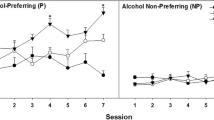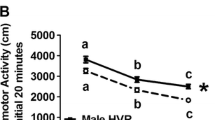Abstract
The FAST and SLOW lines of mice are being selectively bred in replicate for differential sensitivities to the locomotor activating effects of ethanol. Whereas FAST-1 and FAST-2 mice are stimulated by 2.0 g/kg ethanol, SLOW-1 and SLOW-2 mice are not stimulated, and are often depressed, by this dose. The dopamine antagonists, SCH-23390 (D1) and raclopride (D2), produced dose-dependent decreases in the locomotor activity of EtOH-naive mice of both lines and replicates; however, FAST and SLOW mice were not differentially sensitive to these effects. The absence of a line difference in activity response to the dopamine antagonists suggests that dopamine receptor function has not been altered by selective breeding for differences in sensitivity to the stimulant effects of ethanol. The ethanol-stimulated activity of FAST-1 and FAST-2 mice was decreased by administration of the dopamine antagonists, haloperidol and raclopride, at doses that had no effect on basal locomotor activity. SCH-23390 decreased ethanol-stimulated activity of FAST-1, but not FAST-2 mice. The ethanol-induced activity changes of SLOW mice were generally unaffected by antagonist administration. These results suggest a role for dopaminergic systems in mediating ethanol-stimulated activity in selectively bred FAST mice. Coadministration of SCH-23390 and raclopride decreased ethanol-induced activation to a greater degree than either drug alone, further suggesting that both D1 and D2 receptor systems contribute to the full expression of the ethanol stimulant response.
Similar content being viewed by others
References
Alari L, Lewander T, Sjöquist B (1987) The effect of ethanol on the brain catecholamine systems in female mice, rats, and guinea pigs. Alcohol Clin Exp Res 11:144–149
Angehrn W, Schmid E, Althaus F, Niederman K, Rothlin M (1980) Effect of dopamine on hepatosplanchnic blood flow. J Cardiovasc Pharmacol 2:257–265
Austin MC, Kalivas PW (1991) Dopaminergic involvement in locomotion elicited from the ventral pallidum/substantia innominata. Brain Res 542:123–131
Carlsson A, Lindqvist M (1973) Effect of ethanol on the hydroxylation of tyrosine and tryptophan in rat brain in vivo. J Pharm Pharmacol 25:437–440
Chapman BJ, Horn NM, Munday KA, Robertson MJ (1980) The actions of dopamine and of sulpiride on regional blood flows in the rat kidney. J Physiol 298:437–452
Crabbe JC, Young ER, Deutsch CM, Tam BR, Kosobud A (1987) Mice genetically selected for differences in open-field activity after ethanol. Pharmacol Biochem Behav 27:577–581
Crabbe JC, Phillips TJ, Kosobud A, Belknap JK (1990) Estimation of genetic correlation: interpretation of experiments using selectively bred and inbred animals. Alcohol Clin Exp Res 14:141–151
Deitrich RA, Dunwiddie TV, Harris RA, Erwin VG (1989) Mechanism of action of ethanol: Initial central nervous system actions. Pharmacol Rev 41:489–537
Dudek BC, Phillips TJ, Hahn ME (1991) Genetic analyses of the biphasic nature of the alcohol dose-response curve. Alcohol Clin Exp Res 15:262–269
Engel JA, Fahlke C, Hulthe P, Hard E, Johannesen K, Snape B, Svensson L (1988) Biochemical and behavioral evidence for an interaction between ethanol and calcium channel antagonists. J Neural Transm 74:181–193
Goldberg LI (1978) Vascular dopamine receptor as a model for other dopamine receptors. In: Roberts PJ (ed) Advances in Biochemical Pharmacology, vol. 19. Raven Press, New York, pp 119–129
Hyttel J (1983) SCH-23390: the first selective dopamine D1 antagonist. Eur J Pharmacol 91:153–154
Imperato A, DiChiara G (1986) Preferential stimulation of dopamine release in the nucleus accumbens of freely moving rats by ethanol. J Pharmacol Exp Ther 239:219–228
Kalivas PW, Duffy P, Eberhardt H (1990) Modulation of A10 dopamine neurons by γ-aminobutyric acid agonists. J Pharmacol Exp Ther 253:858–866
Keppel G (1991) Design and analysis: a researcher's handbook, 3rd edition. Prentice Hall, New Jersey
Koechling UM, Smith BR, Amit Z (1990) Differential effects of catecholamine antagonists on ethanol-induced excitation in mice. Psychopharmacology 102:234–238
Köhler C, Hall H, Ögren S-O, Gawell L (1985) Specific in vivo and in vitro binding of3H-raclopride, a potent substituted benzamide drug with high affinity for dopamine D2 receptors in the rat brain. Biochem Pharmacol 34:2251–2259
Liljequist S, Berggren U, Engel J (1981) The effect of catecholamine receptor antagonists on ethanol-induced locomotor stimulation. J Neural Transm 50:57–67
Longoni R, Spina L, DiChiara G (1987) Permissive role of D1 receptor stimulation for the expression of D2 mediated behavioral responses: a quantitative phenomenological study in rats. Life Sci 41:2135–2145
Lucchi L, Lupini M, Govoni S, Covelli V, Spano PF, Trabucchi M (1983) Ethanol and dopaminergic systems. Pharmacol Biochem Behav 18:379–382
Lukas SE, Mendelson JH (1988) Electroencephalographic activity and plasma ACTH during ethanol-induced euphoria. Biol Psychiatry 23:141–148
Malmberg A, Jackson DM, Eriksson A, Mohell N (1993) Unique binding characteristics of antipsychotic agents interacting with human dopamine D2A, D2B, and D3 receptors. Mol Pharmacol 43:749–754
Nagahama S, Chen Y-F, Lindheimer MD, Oparil S (1986) Mechanism of the pressor action of LY171555, a specific dopamine D2 receptor agonist, in the conscious rat. J Pharmacol Exp Ther 236:735–742
Nakahiro M, Arakawa O, Narahashi T (1991) Modulation of γ-aminobutyric acid receptor channel complex by alcohols. J Pharmacol Exp Ther 259:235–240
Phillips TJ (1993) Use of genetically distinct mouse populations to explore ethanol reinforcement. Alcohol Alcohol Suppl. 2:451–455
Phillips TJ, Burkhart-Kasch S, Terdal ES, Crabbe JC (1991) Response to selection for ethanol-induced locomotor activation: genetic analyses and selection response characterization. Psychopharmacology 103:557–566
Phillips TJ, Burkhart-Kasch S, Gwiazdon CG, Crabbe JC (1992) Acute sensitivity of FAST and SLOW mice to the effects of abused drugs on locomotor activity. J Pharmacol Exp Ther 261:525–533
Pohorecky L A (1977) Biphasic action of ethanol. Biobehav Rev 1:231–240
Ross SB, Jackson DM, Edwards SR (1989) The involvement of D1 and D2 receptors in the locomotor stimulation produced by (+)-amphetamine in naive and dopamine-depleted mice. Pharmacol Toxicol 64:72–77
Seeman P, Niznik HB (1988) Dopamine D1 receptor pharmacology. In: ISI atlas of science: Pharmacology. Institute for Scientific Information, Philadelphia, Pa., pp 161–170
Sokoloff P, Andrieux M, Besançon R, Pilon C, Martres M-P, Giros B, Schwartz J-C (1992) Pharmacology of human dopamine D3 receptor expressed in a mammalian cell line, comparison with D2 receptor. Eur J Pharmacol 225:331–337
White FJ, Bednarz LJ, Wachtel SR, Hjorth S, Brooderson RJ (1988) Is stimulation of both D1 and D2 receptors necessary for the expression of dopamine-mediated behaviors? Pharmacol Biochem Behav 30:189–193
Wise RA, Bozarth MA (1987) A psychomotor stimulant theory of addiction. Psychol Rev 94:469–492
Author information
Authors and Affiliations
Additional information
This work was supported by the Department of Veterans Affairs, by NIAAA grants AA06498 and AA08621 (J.C.C. and T.J.P.), and by an N. L. Tartar Research Fellowship from the Medical Research Foundation of Oregon (E.H.S.). A portion of this work was completed in partial fulfillment of the requirements for Master of Science degree, Department of Medical Psychology, Oregon Health Sciences University (E.H.S.).
Rights and permissions
About this article
Cite this article
Shen, E.H., Crabbe, J.C. & Phillips, T.J. Dopamine antagonist effects on locomotor activity in naive and ethanol-treated FAST and SLOW selected lines of mice. Psychopharmacology 118, 28–36 (1995). https://doi.org/10.1007/BF02245246
Received:
Revised:
Issue Date:
DOI: https://doi.org/10.1007/BF02245246




